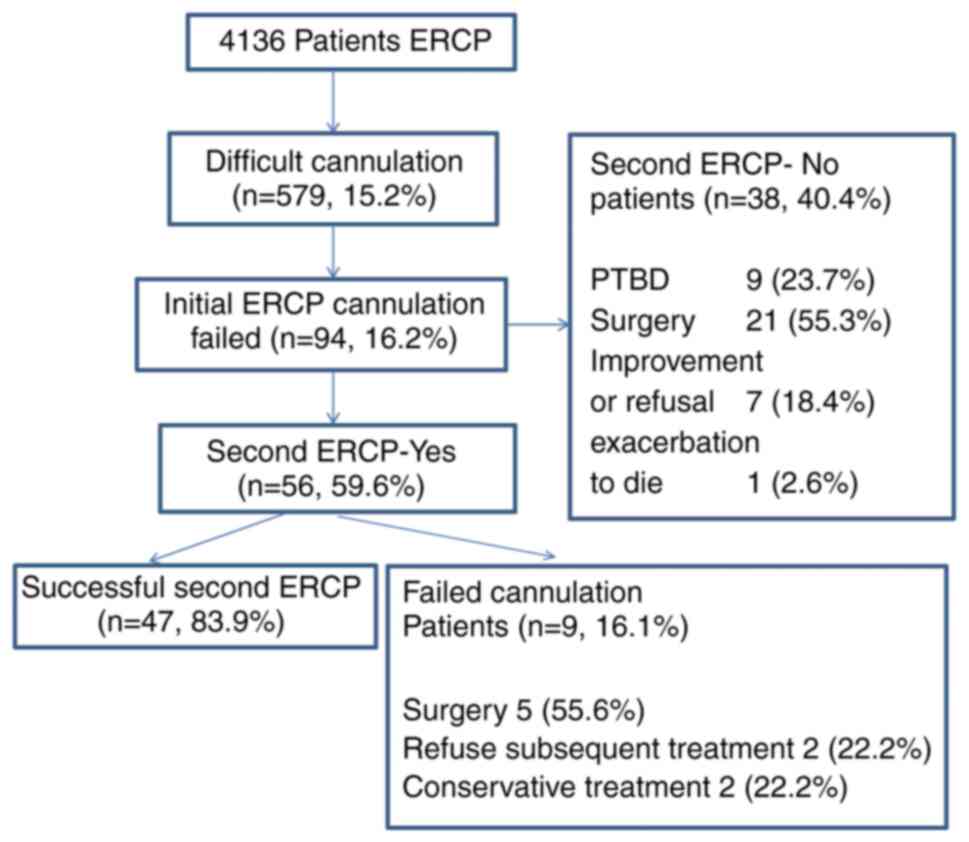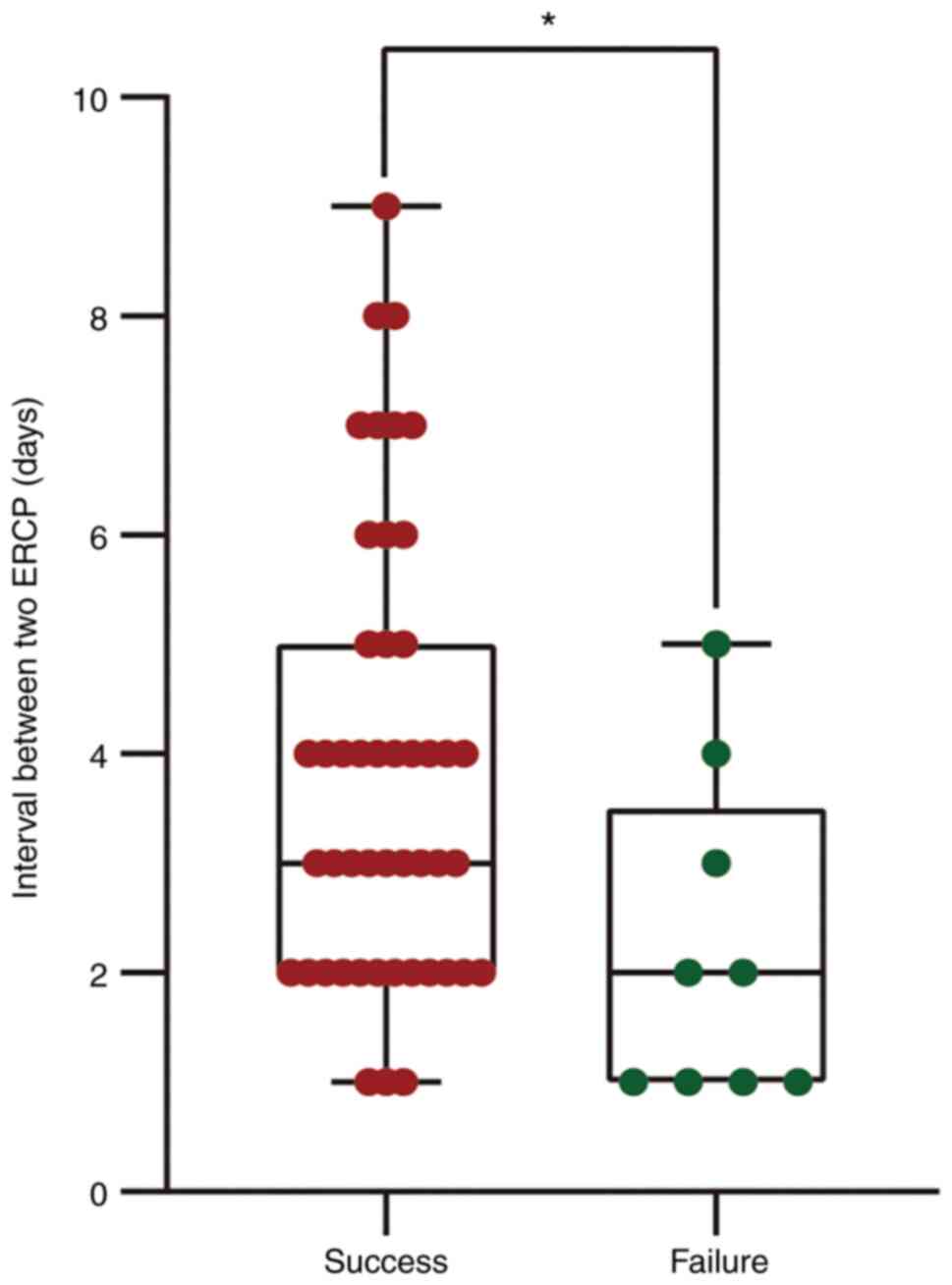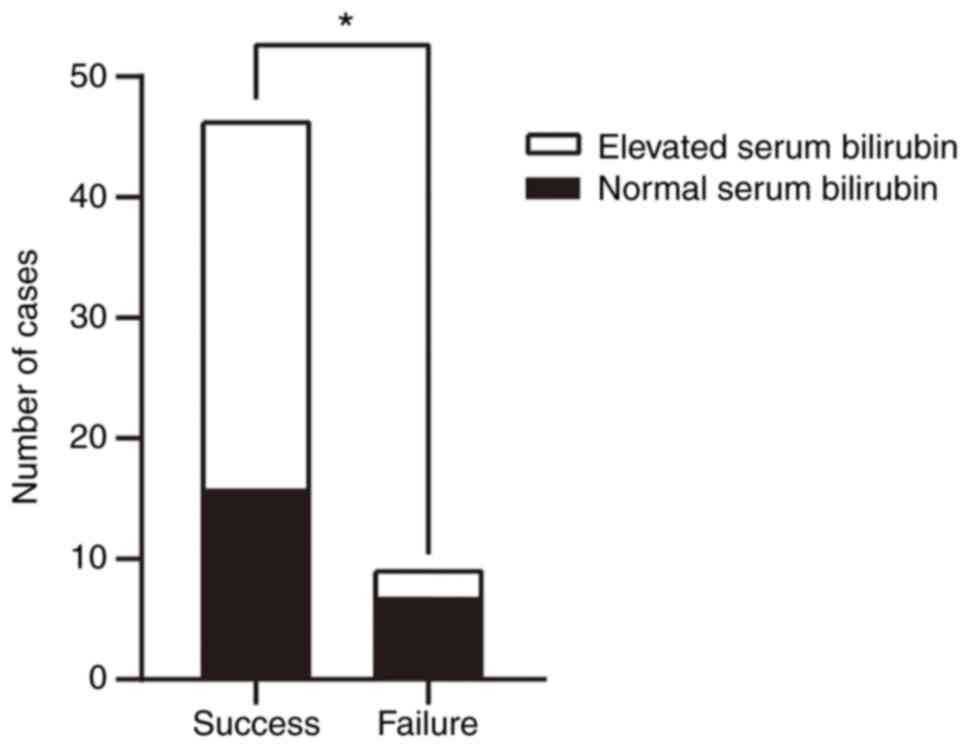|
1
|
Lee YS, Cho CM, Cho KB, Heo J, Jung MK,
Kim SB, Kim KH, Kim TN, Lee DW, Han J, et al: Difficult biliary
cannulation from the perspective of post-endoscopic retrograde
cholangiopancreatography pancreatitis: Identifying the optimal
timing for the rescue cannulation technique. Gut Liver. 15:459–465.
2021.PubMed/NCBI View
Article : Google Scholar
|
|
2
|
Nakai Y, Isayama H, Sasahira N, Kogure H,
Sasaki T, Yamamoto N, Saito K, Umefune G, Akiyama D, Kawahata S, et
al: Risk factors for post-ERCP pancreatitis in wire-guided
cannulation for therapeutic biliary ERCP. Gastrointest Endosc.
81:119–126. 2015.PubMed/NCBI View Article : Google Scholar
|
|
3
|
Chen Q, Jin P, Ji X, Du H and Lu J:
Management of difficult or failed biliary access in initial ERCP: A
review of current literature. Clin Res Hepatol Gastroenterol.
43:365–372. 2019.PubMed/NCBI View Article : Google Scholar
|
|
4
|
Cennamo V, Fuccio L, Zagari RM, Eusebi LH,
Ceroni L, Laterza L, Fabbri C and Bazzoli F: Can early precut
implementation reduce endoscopic retrograde
cholangiopancreatography-related complication risk? Meta-analysis
of randomized controlled trials. Endoscopy. 42:381–388.
2010.PubMed/NCBI View Article : Google Scholar
|
|
5
|
Williams EJ, Ogollah R, Thomas P, Logan
RF, Martin D, Wilkinson ML and Lombard M: What predicts failed
cannulation and therapy at ERCP? Results of a large-scale
multicenter analysis. Endoscopy. 44:674–683. 2012.PubMed/NCBI View Article : Google Scholar
|
|
6
|
Altonbary AY and Bahgat MH: Endoscopic
retrograde cholangiopancreatography in periampullary diverticulum:
The challenge of cannulation. World J Gastrointest Endosc.
8:282–287. 2016.PubMed/NCBI View Article : Google Scholar
|
|
7
|
Krutsri C, Kida M, Yamauchi H, Iwai T,
Imaizumi H and Koizumi W: Current status of endoscopic retrograde
cholangiopancreatography in patients with surgically altered
anatomy. World J Gastroenterol. 25:3313–3333. 2019.PubMed/NCBI View Article : Google Scholar
|
|
8
|
ASGE Technology Committee. Enestvedt BK,
Kothari S, Pannala R, Yang J, Fujii-Lau LL, Hwang JH, Konda V,
Manfredi M, Maple JT, et al: Devices and techniques for ERCP in the
surgically altered GI tract. Gastrointest Endosc. 83:1061–1075.
2016.PubMed/NCBI View Article : Google Scholar
|
|
9
|
Colan-Hernandez J, Aldana A, Concepción M,
Chavez K, Gómez C, Mendez-Bocanegra A, Martínez-Guillen M, Sendino
O, Villanueva C, Llach J, et al: Optimal timing for a second ERCP
after failure of initial biliary cannulation following precut
sphincterotomy: An analysis of experience at two tertiary centers.
Surg Endosc. 31:3711–3717. 2017.PubMed/NCBI View Article : Google Scholar
|
|
10
|
Pavlides M, Barnabas A, Fernandopulle N,
Bailey AA, Collier J, Phillips-Hughes J, Ellis A, Chapman R and
Braden B: Repeat endoscopic retrograde cholangiopancreaticography
after failed initial precut sphincterotomy for biliary cannulation.
World J Gastroenterol. 20:13153–13158. 2014.PubMed/NCBI View Article : Google Scholar
|
|
11
|
Bokemeyer A, Muller F, Niesert H, Brückner
M, Bettenworth D, Nowacki T, Beyna T, Ullerich H and Lenze F:
Percutaneous-transhepatic-endoscopic rendezvous procedures are
effective and safe in patients with refractory bile duct
obstruction. United European Gastroenterol J. 7:397–404.
2019.PubMed/NCBI View Article : Google Scholar
|
|
12
|
Lorenz JM: Management of malignant biliary
obstruction. Semin Intervent Radiol. 33:259–267. 2016.PubMed/NCBI View Article : Google Scholar
|
|
13
|
Abbas AM, Strong AT, Diehl DL, Brauer BC,
Lee IH, Burbridge R, Zivny J, Higa JT, Falcão M, El Hajj II, et al:
Multicenter evaluation of the clinical utility of
laparoscopy-assisted ERCP in patients with Roux-en-Y gastric
bypass. Gastrointest Endosc. 87:1031–1039. 2018.PubMed/NCBI View Article : Google Scholar
|
|
14
|
Huang RJ, Thosani NC, Barakat MT,
Choudhary A, Mithal A, Singh G, Sethi S and Banerjee S: Evolution
in the utilization of biliary interventions in the United States:
Results of a nationwide longitudinal study from 1998 to 2013.
Gastrointest Endosc. 86:319–326.e5. 2017.PubMed/NCBI View Article : Google Scholar
|
|
15
|
Testoni PA, Mariani A, Aabakken L,
Arvanitakis M, Bories E, Costamagna G, Devière J, Dinis-Ribeiro M,
Dumonceau JM, Giovannini M, et al: Papillary cannulation and
sphincterotomy techniques at ERCP: European society of
gastrointestinal endoscopy (ESGE) clinical guideline. Endoscopy.
48:657–683. 2016.PubMed/NCBI View Article : Google Scholar
|
|
16
|
Liao WC, Angsuwatcharakon P, Isayama H,
Dhir V, Devereaux B, Khor CJ, Ponnudurai R, Lakhtakia S, Lee DK,
Ratanachu-Ek T, et al: International consensus recommendations for
difficult biliary access. Gastrointest Endosc. 85:295–304.
2017.PubMed/NCBI View Article : Google Scholar
|
|
17
|
Haraldsson E, Kylänpää L, Grönroos J,
Saarela A, Toth E, Qvigstad G, Hult M, Lindström O, Laine S,
Karjula H, et al: Macroscopic appearance of the major duodenal
papilla influences bile duct cannulation: A prospective multicenter
study by the scandinavian association for digestive endoscopy study
group for ERCP. Gastrointest Endosc. 90:957–963. 2019.PubMed/NCBI View Article : Google Scholar
|
|
18
|
Chen PH, Tung CF, Peng YC, Yeh HZ, Chang
CS and Chen CC: Duodenal major papilla morphology can affect
biliary cannulation and complications during ERCP, an observational
study. BMC Gastroenterol. 20(310)2020.PubMed/NCBI View Article : Google Scholar
|
|
19
|
ASGE Training Committee. Jorgensen J,
Kubiliun N, Law JK, Al-Haddad MA, Bingener-Casey J, Christie JA,
Davila RE, Kwon RS, Obstein KL, et al: Endoscopic retrograde
cholangiopancreatography (ERCP): Core curriculum. Gastrointest
Endosc. 83:279–289. 2016.PubMed/NCBI View Article : Google Scholar
|
|
20
|
Wani S, Han S, Simon V, Hall M, Early D,
Aagaard E, Abidi WM, Banerjee S, Baron TH, Bartel M, et al: Setting
minimum standards for training in EUS and ERCP: Results from a
prospective multicenter study evaluating learning curves and
competence among advanced endoscopy trainees. Gastrointest Endosc.
89:1160–1168.e9. 2019.PubMed/NCBI View Article : Google Scholar
|
|
21
|
ASGE Standards of Practice Committee.
Chandrasekhara V, Khashab MA, Muthusamy VR, Acosta RD, Agrawal D,
Bruining DH, Eloubeidi MA, Fanelli RD, Faulx AL, et al: Adverse
events associated with ERCP. Gastrointest Endosc. 85:32–47.
2017.PubMed/NCBI View Article : Google Scholar
|
|
22
|
Williams EJ, Taylor S, Fairclough P,
Hamlyn A, Logan RF, Martin D, Riley SA, Veitch P, Wilkinson M,
Williamson PR, et al: Are we meeting the standards set for
endoscopy? Results of a large-scale prospective survey of
endoscopic retrograde cholangio-pancreatograph practice. Gut.
56:821–829. 2007.PubMed/NCBI View Article : Google Scholar
|
|
23
|
Jin YJ, Jeong S and Lee DH: Utility of
needle-knife fistulotomy as an initial method of biliary
cannulation to prevent post-ERCP pancreatitis in a highly selected
at-risk group: A single-arm prospective feasibility study.
Gastrointest Endosc. 84:808–813. 2016.PubMed/NCBI View Article : Google Scholar
|
|
24
|
Fiocca F, Fanello G, Cereatti F, Maselli
R, Ceci V and Donatelli G: Early ‘shallow’ needle-knife papillotomy
and guidewire cannulation: An effective and safe approach to
difficult papilla. Therap Adv Gastroenterol. 8:114–120.
2015.PubMed/NCBI View Article : Google Scholar
|
|
25
|
Kevans D, Zeb F, Donnellan F, Courtney G
and Aftab AR: Failed biliary access following needle knife
fistulotomy: Is repeat interval ERCP worthwhile? Scand J
Gastroenterol. 45:1238–1241. 2010.PubMed/NCBI View Article : Google Scholar
|
|
26
|
Kim J, Ryu JK, Ahn DW, Park JK, Yoon WJ,
Kim YT and Yoon YB: Results of repeat endoscopic retrograde
cholangiopancreatography after initial biliary cannulation failure
following needle-knife sphincterotomy. J Gastroenterol Hepatol.
27:516–520. 2012.PubMed/NCBI View Article : Google Scholar
|
|
27
|
Donnellan F, Enns R, Kim E, Amar J,
Telford J and Byrne MF: Outcome of repeat ERCP after initial failed
use of a needle knife for biliary access. Dig Dis Sci.
57:1069–1071. 2012.PubMed/NCBI View Article : Google Scholar
|
|
28
|
Lo MH, Lin CH, Wu CH, Tsou YK, Lee MH,
Sung KF and Liu NJ: Management of biliary diseases after the
failure of initial needle knife precut sphincterotomy for biliary
cannulation. Sci Rep. 11(14968)2021.PubMed/NCBI View Article : Google Scholar
|
|
29
|
Peñaloza Ramírez A, Rodríguez Tello D,
Murillo Arias A, Barreto Pérez J and Aponte Ordóñez P: Endoscopic
retrograde cholangiopancreatography results three days after a
failed pre-cut. Rev Esp Enferm Dig. 113:486–489. 2021.PubMed/NCBI View Article : Google Scholar
|
|
30
|
Flumignan VK, Seike MG, Souza VS,
Cirqueira MI, Silva AB and Artifon ELA: Difficult biliary
cannulation: Should we always try a second ercp after a failed
needle-knife fistulotomy? Arq Gastroenterol. 58:509–513.
2021.PubMed/NCBI View Article : Google Scholar
|
|
31
|
Kaffes AJ, Sriram PV, Rao GV, Santosh D
and Reddy DN: Early institution of pre-cutting for difficult
biliary cannulation: A prospective study comparing conventional vs.
a modified technique. Gastrointest Endosc. 62:669–674.
2005.PubMed/NCBI View Article : Google Scholar
|
|
32
|
Ang TL, Kwek AB, Lim KB, Teo EK and Fock
KM: An analysis of the efficacy and safety of a strategy of early
precut for biliary access during difficult endoscopic retrograde
cholangiopancreatography in a general hospital. J Dig Dis.
11:306–312. 2010.PubMed/NCBI View Article : Google Scholar
|
|
33
|
Harewood GC and Baron TH: An assessment of
the learning curve for precut biliary sphincterotomy. Am J
Gastroenterol. 97:1708–1712. 2002.PubMed/NCBI View Article : Google Scholar
|
|
34
|
Akaraviputh T, Lohsiriwat V, Swangsri J,
Methasate A, Leelakusolvong S and Lertakayamanee N: The learning
curve for safety and success of precut sphincterotomy for
therapeutic ERCP: A single endoscopist's experience. Endoscopy.
40:513–516. 2008.PubMed/NCBI View Article : Google Scholar
|
|
35
|
Dumonceau JM, Kapral C, Aabakken L,
Papanikolaou IS, Tringali A, Vanbiervliet G, Beyna T, Dinis-Ribeiro
M, Hritz I, Mariani A, et al: ERCP-related adverse events: European
society of gastrointestinal endoscopy (ESGE) guideline. Endoscopy.
52:127–149. 2020.PubMed/NCBI View Article : Google Scholar
|
|
36
|
Fung BM, Pitea TC and Tabibian JH:
Difficult biliary cannulation in endoscopic retrograde
cholangiopancreatography: Definitions, risk factors, and
implications. Eur Med J Hepatol. 9:64–72. 2021.PubMed/NCBI
|
|
37
|
Halttunen J, Meisner S, Aabakken L, Arnelo
U, Grönroos J, Hauge T, Kleveland PM, Nordblad Schmidt P, Saarela
A, Swahn F, et al: Difficult cannulation as defined by a
prospective study of the scandinavian association for digestive
endoscopy (SADE) in 907 ERCPs. Scand J Gastroenterol. 49:752–758.
2014.PubMed/NCBI View Article : Google Scholar
|
|
38
|
Watanabe M, Okuwaki K, Kida M, Imaizumi H,
Yamauchi H, Kaneko T, Iwai T, Hasegawa R, Miyata E, Masutani H, et
al: Transpapillary biliary cannulation is difficult in cases with
large oral protrusion of the duodenal papilla. Dig Dis Sci.
64:2291–2299. 2019.PubMed/NCBI View Article : Google Scholar
|
|
39
|
Freeman ML, DiSario JA, Nelson DB,
Fennerty MB, Lee JG, Bjorkman DJ, Overby CS, Aas J, Ryan ME, Bochna
GS, et al: Risk factors for post-ERCP pancreatitis: A prospective,
multicenter study. Gastrointest Endosc. 54:425–434. 2001.PubMed/NCBI View Article : Google Scholar
|
|
40
|
Saito H, Kadono Y, Shono T, Kamikawa K,
Urata A, Nasu J, Imamura H, Matsushita I, Kakuma T and Tada S:
Factors predicting difficult biliary cannulation during endoscopic
retrograde cholangiopancreatography for common bile duct stones.
Clin Endosc: Nov 12, 2021 (Epub ahead of print).
|
|
41
|
Zhou PH, Yao LQ, Xu MD, Zhong YS, Gao WD,
He GJ, Zhang YQ, Chen WF and Qin XY: Application of needle-knife in
difficult biliary cannulation for endoscopic retrograde
cholangiopancreatography. Hepatobiliary Pancreat Dis Int.
5:590–594. 2006.PubMed/NCBI
|
|
42
|
Lopes L, Canena J, Fernandes J, Moreira M,
Costa I, Gomes-Fonseca J, Araújo T, Alexandrino G, Lourenço L,
Horta D, et al: Should we use papilla morphology to estimate the
size of the terminal common bile duct during endoscopic retrograde
cholangiopancreatography? Eur J Gastroenterol Hepatol. 32:181–186.
2020.PubMed/NCBI View Article : Google Scholar
|
|
43
|
Xiao L, Geng C, Li X, Li Y and Wang C:
Comparable safety of ERCP in symptomatic and asymptomatic patients
with common bile duct stones: A propensity-matched analysis. Scand
J Gastroenterol. 56:111–117. 2021.PubMed/NCBI View Article : Google Scholar
|
|
44
|
Kadokura M, Takenaka Y, Yoda H, Yasumura
T, Okuwaki T, Tanaka K and Amemiya F: Asymptomatic common bile duct
stones are associated with increased risk of post-endoscopic
retrograde cholangiopancreatography pancreatitis. JMA J. 4:141–147.
2021.PubMed/NCBI View Article : Google Scholar
|
|
45
|
Kuo CM, Chiu YC, Changchien CS, Tai WC,
Chuah SK, Hu TH, Kuo YH and Kuo CH: Endoscopic papillary balloon
dilation for removal of bile duct stones: Evaluation of outcomes
and complications in 298 patients. J Clin Gastroenterol.
46:860–864. 2012.PubMed/NCBI View Article : Google Scholar
|
|
46
|
Testoni PA, Mariani A, Giussani A, Vailati
C, Masci E, Macarri G, Ghezzo L, Familiari L, Giardullo N and
Mutignani M: , et al: Risk factors for post-ERCP
pancreatitis in high- and low-volume centers and among expert and
non-expert operators: A prospective multicenter study. Am J
Gastroenterol. 105:1753–1761. 2010.PubMed/NCBI View Article : Google Scholar
|

















